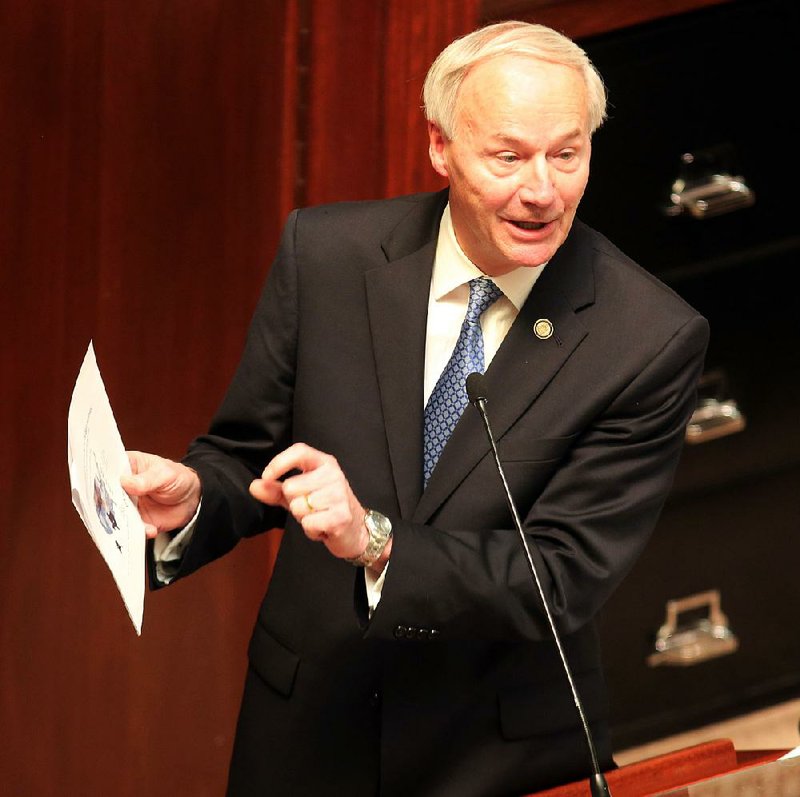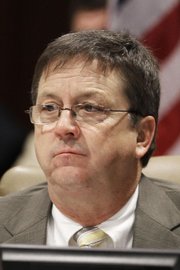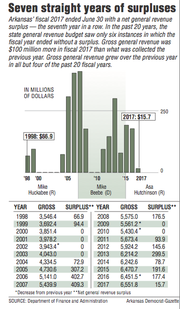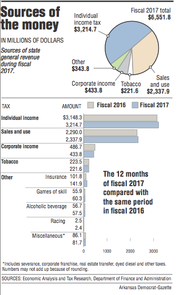Arkansas' state government ended fiscal 2017 with record general revenue and a $15.7 million surplus after tax collections seesawed above and below forecast over most of the past 12 months, officials said Wednesday.
The state Department of Finance and Administration reported the surplus in a monthly report Wednesday. On Friday, the last day of the state's fiscal year, Gov. Asa Hutchinson's administration restored all but $10 million of a $70 million budget cut announced in late April amid fears of a revenue shortfall.
In restoring much of the cut, Finance and Administration Director Larry Walther on Friday cited rebounding tax collections and much lower-than-expected individual income tax refunds. When the budget cut was announced in April, Hutchinson pointed to lower-than-expected sales and corporate income tax collections, and higher-than-expected individual income tax refunds.
"Our economy is strong and growing and the most-recent revenue report confirms that fact," the Republican governor said Wednesday in a written statement. "From the revenue report, we can see that Arkansans are working hard and earning more. We can also see that consumer and business spending are stronger, which is a good sign both for our budgets and for the state's economy."
Asked if he considered not restoring much of the budget cut and saving the $60 million as additional surplus, Hutchinson said, "Our primary goal was replenishing the Medicaid Trust Fund, and adjusting the forecast was necessary to do that. With uncertainty in Washington and the possible changes to Medicaid, it is an appropriate step to assure a strong foundation for the coming years."
The Medicaid Trust Fund is used to help match federal dollars for the Medicaid program. One of the funding sources is a tax on soft drinks.
"By revising the forecast on Friday, we were able to move $43 million in additional money into the Medicaid Trust Fund, which brings it to about almost $70 million," Walther said Wednesday.
The Republican-controlled Congress is considering measures to repeal and replace the federal Patient Protection and Affordable Care Act, under which the state is authorized to receive federal funding for its version of Medicaid expansion called Arkansas Works.
The state provides private health insurance for roughly 300,000 Arkansans under the program, with the federal government paying for 95 percent and the state chipping in 5 percent this year. The state is projected to pay $109 million of the program's $1.8 billion cost in fiscal 2018. The state's share will increase each year until it reaches 10 percent in 2020 under existing federal law.
During fiscal 2017, Arkansas' gross general revenue totaled $6.55 billion -- an increase of $100.4 million, or 1.6 percent, above fiscal 2016. Total collections also exceeded the latest forecast by $18.2 million, the finance department reported Wednesday.
The previous record for a fiscal year's total general-revenue collections was in fiscal 2015, when they totaled $6.47 billion, according to John Shelnutt, the state's chief economic forecaster.
House Speaker Jeremy Gillam, R-Judsonia, said he's encouraged by Friday's restoration of much of the earlier budget cut and by Wednesday's revenue report.
"This is a much better scenario to find ourselves in than forecasts being in the opposite direction where the revenues coming in were significantly below the revised forecast," Gillam said. "Overall, I think to finish out the fiscal year the way we're able to do is great news. I think it puts us on some pretty good footing moving into the next fiscal year."
A Joint Budget Committee co-chairman, Sen. Larry Teague, D-Nashville, said, "It's always better to have a surplus than to be in a hole." Arkansas is barred under state law from spending more than it collects in taxes.
The $15.7 million surplus is less than surpluses in each of the previous six fiscal years. Those ranged from $78.7 million in fiscal 2014 to $299.5 million in fiscal 2013, according to Finance and Administration Department records.
Those records show that the largest surplus over the past 20 fiscal years was $409.4 million in fiscal 2007.
Arkansas tax refunds and some special government expenditures, such as court-mandated desegregation payments, come off the top of total revenue, leaving a net amount. In fiscal 2017, net available general revenue totaled $5.349 billion -- a decrease of $19 million from fiscal 2016 and $25.7 million above the latest forecast.
Paul Louthian, deputy director of the finance department, said the $15.7 million surplus was calculated based on net available general revenue of $5.349 billion exceeding the original general-revenue budget of $5.333 billion under the Revenue Stabilization Act. The act was passed by the Republican-controlled Legislature and Hutchinson in the 2016 fiscal session.
Louthian said the finance department transferred $25.7 million -- or the amount by which total net general revenue exceeded Friday's revised $5.323 billion budget -- to the General Revenue Allotment Fund on Friday.
"Additional amounts of reclaimed general revenue [from state agencies for fiscal 2017] will occur through August," and go to the General Revenue Allotment Fund, he said. Spending money from that fund would require the authorization of the Legislature and the governor, Louthian said.
During this year's regular legislative session, the Legislature and Hutchinson passed a $5.49 billion general-revenue budget for fiscal 2018, which started Saturday. Two months ago, Hutchinson trimmed that budget by $43 million.
Asked if the state will now change the fiscal 2018 forecast, Walther said, "We'll be looking at it again at the end of November, early December," as required under state law.
Across the country, governors are being "extra cautious" with their budgets for fiscal 2018 "as states contend with slow growth, limited budget flexibility and substantial federal uncertainty," according to a recent report from the National Association of State Budget Officers.
In fiscal 2017, states experienced sluggish revenue growth of 2.4 percent, with 33 states reporting collections below projections. At least 23 states made midyear 2017 budget cuts totaling $4.9 billion, the association reported.
"Looking back at fiscal year 2017, it was a difficult year," Walther said.
"We started out with corporate income tax being well below what we had forecasted because some corporate filers were doing some tax planning. They literally overpaid in 2016, and therefore didn't ask for a refund. We didn't see that, so it caused us to be well behind from the very beginning," he said.
"The good thing is the individual income tax has been pretty much on line with what we forecasted. We have had a good year in individual income tax withholdings, so ... we're thinking the economy is still strong and looking strong into 2018," Walther said.
According to the finance department breakdown of fiscal 2017 general-revenue figures by category were:
• A $66.5 million, or 2.1 percent, increase in individual income tax collections over fiscal 2016 to $3.21 billion, which exceeded the forecast by $3.1 million, or 0.1 percent.
• A $48 million, or 2.1 percent, increase in sales and use tax collections over fiscal 2016 to $2.33 billion, which exceeded the forecast by $2.6 million, or 0.1 percent.
• A $52.9 million, or 10.9 percent, decline in corporate income tax collections from fiscal 2016 to $433.8 million, which exceeded the forecast by $4.6 million, or 1.1 percent.
The fiscal 2017 figures also showed:
• Individual income tax refunds increased by $80.1 million, or 21.9 percent over fiscal 2016 to $447 million, which was $6.2 million, or 1.4 percent, below forecast. This added to net general revenue.
The state record for total general-revenue collections in the month of June continues to be $670.3 million in 2015, Shelnutt said. This year, total collections in June were $666.1 million.
Net available general revenue for the month increased by $30 million over a year ago to $571.7 million, which exceeded forecast by $25.7 million.
June's individual income tax collections increased by $6.6 million to $276.8 million and exceeded forecast by $3.1 million.
Individual income tax withholdings are the largest category of those collections. They totaled $198.5 million in June -- a $9.9 million increase over a year ago and a $3.1 million increase over the state's forecast, Shelnutt said.
Last month's sales and use tax collections increased by $7.9 million from a year ago to $202.8 million and exceeded forecast by $2.6 million.
The increase in sales and use tax collections "was across the board of [both] consumers and business, with the exception of motor vehicle that was flat and has been flat for a few months," Shelnutt said.
June's corporate income tax collections declined by $16.2 million, or 19 percent, from year-ago figures to $68.8 million, but that's $4.6 million above the latest forecast.
Louthian said federal and state governments changed the due date for corporate income tax filings from March 15 to April 15, so "what we normally would have as due in June now will be due in July."
A Section on 07/06/2017





